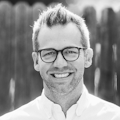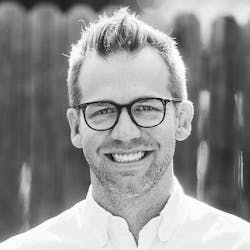Put down the tech: Humanitarian hope for health care
“Take warning from all those times when, on meeting again, we feel ashamed because we realize we had accepted the false simplification which absence permits, its obliteration of all those characteristics which, when we meet face-to-face, force themselves upon even the blindest. Where human beings are concerned, the statement ‘nothing is true’ is true—at a distance—and the converse is also true—at the moment of confrontation.” —Dag Hammarskjöld, Markings, 19501
Written more than 70 years ago, these words from the second United Nations secretary-general and renowned Swedish peacemaker may never more deeply resonate than they do at this very moment. The rise of the smartphone and social media have managed to create distance despite proximity, isolation when occupying the same room. While the pitfalls of this artificial separation become increasingly obvious in our personal lives, their immediate application to modern health care may be slightly less obvious. But in this technological age, health care has often too acquiesced to the culture of cure before care, and, in the process, a wedge has been driven between the doctor and patient.
As a clinician, I often ask myself what will it take to truly see patients in front of me instead of their disease state? What style and skills can help me close the gap and meet someone face-to-face? Given the multifaceted complexity of this problem, it’s obvious no one answer is a panacea, but I’d like to offer two small steps that I think will help patients and clinicians turn toward each other and, ultimately, a solution.
First step: Put down the technology
The first step is simply admitting that technology is a good servant but a poor master. In his searing indictment of the primacy of technology in modern culture, Neil Postman wrote in his book, Technopoly: The Surrender of Culture to Technology: “Technopoly is a state of culture. It is also a state of mind. It consists in the deification of technology, which means that the culture seeks its authorization in technology, finds its satisfactions in technology, and takes its orders from technology.”2 Later in the same book, he wrote, “Computers make it easy to convert facts into statistics and to translate problems into equations. And whereas this can be useful (as when the process reveals a pattern that would otherwise go unnoticed), it is diversionary and dangerous when applied indiscriminately to human affairs.”2
Alas, no electronic health record or app will solve our health problems, certainly not one rooted in a lack of humanity in the health-care system. Still, despite patient desires to feel heard and physician desires to connect with patients, many visits seem to begin in the same fashion: phone in the hand of the patient and computer in the lap of the clinician. What if we put down the technology—even just for a few minutes—and with nonverbal communication such as body position and eye contact as reinforcement, began a real, human conversation?
Research shows that patients view physicians who do exactly this as more compassionate and professional and as better communicators than those using a computer.3 While the computer may become a necessity at some point during the visit, there are ways to create partnership in the presence of a screen. Questions such as, “Would you like to see your xrays?” and “Perhaps we can review your information on the computer together?” involve everyone in the conversation and prevent patients from feeling like they are sneaking a forbidden peek over the shoulder of the clinician as he or she enters necessary information into the electronic record.
Second step: Listen to your patients
Having taken this countercultural step...perhaps it’s a leap...a second stride to helping practitioners and patients truly see each other is based on the recognition of health-care’s paternalistic past and the benefits of a more egalitarian future. A conversation, by definition, has at least two voices, but many interactions in a health-care professional’s office feel much more like a monologue than a dialogue. Even when patients do have the floor, research shows it takes clinicians an average of 11 seconds before interrupting.4
So, instead of pointing fingers while lecturing, practitioners must learn to stack hands while listening. Having disabused myself of the idea that imparting my knowledge is the most important element of an office visit, I consistently hear patients tell me, “No one has ever listened to me like this before.” And despite speaking with a traditionally feared dentist, I once had a patient say, “This feels as good as therapy. Can I come here every week?”
As research increasingly shows, communication styles that promote active listening help improve patient satisfaction and health outcomes and may improve clinician satisfaction as well.5-7 This true conversation prevents the false simplifications that occur when we lift our voice in an echo chamber, instead turning the offices of health-care professionals into sacred spaces where trusting, authentic relationships can be formed.
I often hear that the solution to making health care more human is via policy. “If only payment systems would change, then I would have more time and be present with my patient” is a common refrain. Some propose that educational reform in professional school will have the desired effect. While these changes would certainly yield big, important results (I am all for financial and educational policy shifts), this ignores the small changes...those personal choices that we can make now.
Wendell Berry, ever the humanitarian visionary, said, “Here we come to the reassuring difference between changes in policy and change in principle. The needed policy changes, though addressed to present evils, wait upon the future, and so are presently nonexistent. But changes in principle can be made now, by so few as just one of us…Insofar as they are possible now, exist now, are actual and exemplary now, they give hope.”8
We need hope in health care right now, both as practitioners and as patients. Taking the two small steps of reducing technology use and actively listening to each other can provide that glimmer of hope and remind us that seeing each other face-to-face is a gift of our humanity.
Editor’s note: This article first appeared in Through the Loupes newsletter, a publication of the Endeavor Business Media Dental Group. Read more articles and subscribe to Through the Loupes.
References
- Hammarskjöld D. Markings. Auden WH, Sjöberg L, translators. London: Faber and Faber; 1965.
- Postman N. Technopoly: The Surrender of Culture to Technology. New York: Knopf; 1992.
- Haider A, Tanco K, Epner M, et al. Physicians' compassion, communication skills, and professionalism with and without physicians' use of an examination room computer: a randomized clinical trial. JAMA Oncol. 2018;4(6):879-881. doi:10.1001/jamaoncol.2018.0343
- Singh Ospina N, Phillips KA, Rodriguez-Gutierrez R, et al. Eliciting the patient's agenda– secondary analysis of recorded clinical encounters. J Gen Intern Med. 2019;34(1):36-40. doi:10.1007/s11606-018-4540-5
- Sepucha KR, Atlas SJ, Chang Y, et al. Informed, patient-centered decisions associated with better health outcomes in orthopedics: prospective cohort study. Med Decis Making. 2018;38(8):1018-1026. doi:10.1177/0272989X18801308
- Maslach C, Schaufeli WB, Leiter MP. Job burnout. Annu Rev Psychol. 2001;52:397-422. doi:10.1146/annurev.psych.52.1.397
- Dobler CC, West CP, Montori VM. Can shared decision making improve physician well-being and reduce burnout? Cureus. 2017;9(8):e1615. doi:10.7759/cureus.1615
- Berry W. Our Only World: Ten Essays. Berkeley, CA: Counterpoint; 2015.
About the Author

Matthew Allen, DDS
Matthew Allen, DDS, is the CEO and cofounder of DifferentKind. He has spent his career making dental care more human. Dr. Allen is the only US-based dentist member of MINT, the Motivational Interviewing Network of Trainers, and has championed this person-centered communication style as a sought-after consultant, author, speaker, and advocate. He remains active in clinical practice at a nationally recognized community health center in Denver, where he was previously the dental director. He also serves as part-time volunteer faculty at the University of Colorado School of Dental Medicine.

